Health and Fitness Standards at Workplace to Increase Productivity
VerifiedAdded on 2022/09/11
|12
|3023
|25
Report
AI Summary
This report investigates the influence of health and wellness standards on organizational productivity and performance. It begins with an abstract and introduction highlighting the importance of human capital and the impact of employee health on work behavior, attendance, and overall productivity. The report identifies the problem statement as understanding the impact of wellness and health standards on organizational productivity, addressing the issues of absenteeism and presenteeism. Research questions explore the influence of health and wellness standards, integration of wellness plans, and practical strategies for a healthy workplace. The discussion section examines the changing workforce demographics, the impact of work-related illness and accidents, and the benefits of investing in wellness standards. It also explores areas of influence for integrating wellness plans, including physical work surroundings, psychosocial work conditions, personal health resources, and community engagement. The report concludes with recommendations for promoting healthier attitudes, enhancing physical activity, encouraging good nutrition, and educating employees on healthy lifestyles. It emphasizes the direct impact of worker health and wellness on organizational growth and provides strategies for fostering a competitive and productive work environment. The report provides an action plan and solutions for establishing wellness standards at work and promoting a healthy workplace.
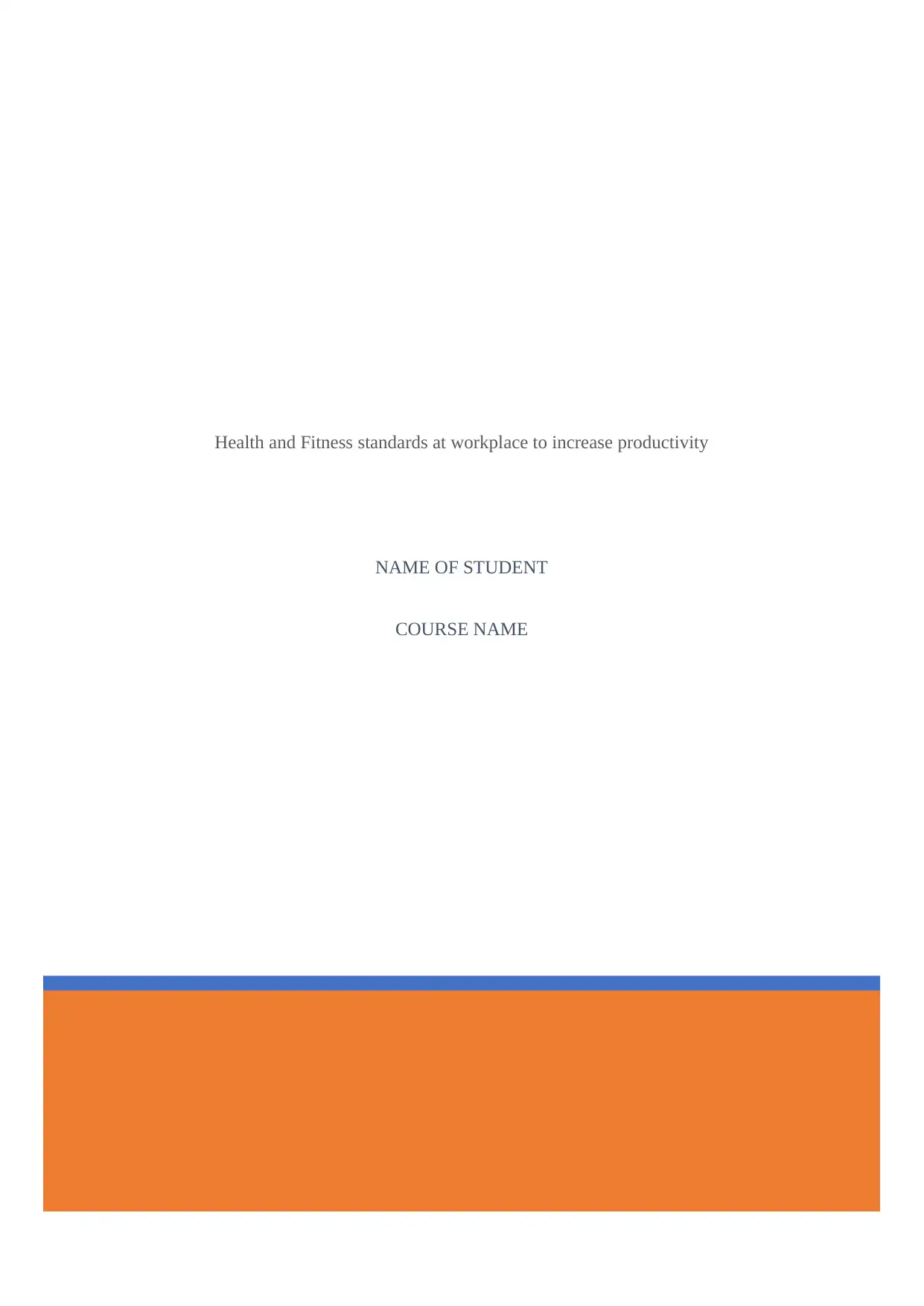
Health and Fitness standards at workplace to increase productivity
NAME OF STUDENT
COURSE NAME
NAME OF STUDENT
COURSE NAME
Paraphrase This Document
Need a fresh take? Get an instant paraphrase of this document with our AI Paraphraser
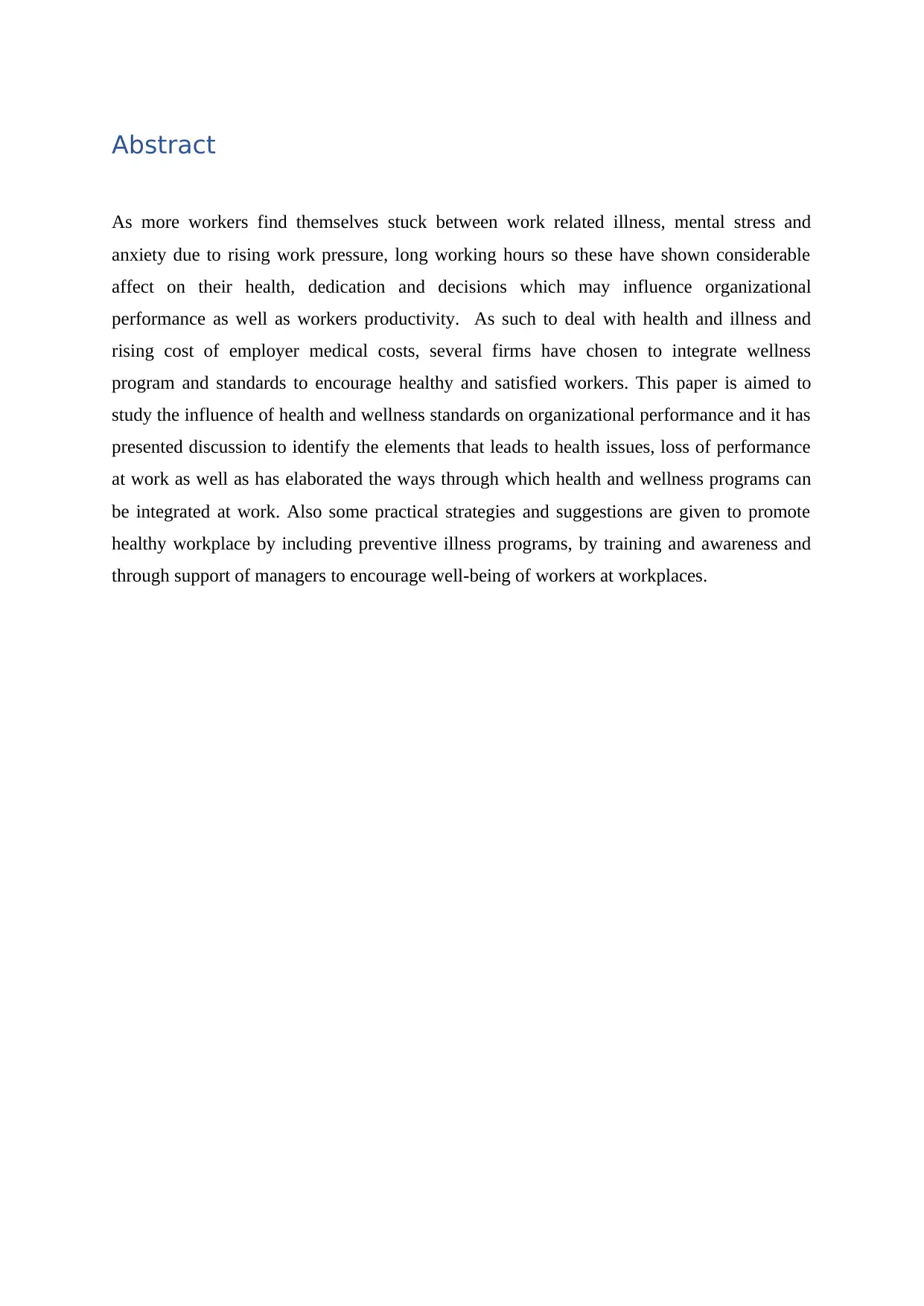
Abstract
As more workers find themselves stuck between work related illness, mental stress and
anxiety due to rising work pressure, long working hours so these have shown considerable
affect on their health, dedication and decisions which may influence organizational
performance as well as workers productivity. As such to deal with health and illness and
rising cost of employer medical costs, several firms have chosen to integrate wellness
program and standards to encourage healthy and satisfied workers. This paper is aimed to
study the influence of health and wellness standards on organizational performance and it has
presented discussion to identify the elements that leads to health issues, loss of performance
at work as well as has elaborated the ways through which health and wellness programs can
be integrated at work. Also some practical strategies and suggestions are given to promote
healthy workplace by including preventive illness programs, by training and awareness and
through support of managers to encourage well-being of workers at workplaces.
As more workers find themselves stuck between work related illness, mental stress and
anxiety due to rising work pressure, long working hours so these have shown considerable
affect on their health, dedication and decisions which may influence organizational
performance as well as workers productivity. As such to deal with health and illness and
rising cost of employer medical costs, several firms have chosen to integrate wellness
program and standards to encourage healthy and satisfied workers. This paper is aimed to
study the influence of health and wellness standards on organizational performance and it has
presented discussion to identify the elements that leads to health issues, loss of performance
at work as well as has elaborated the ways through which health and wellness programs can
be integrated at work. Also some practical strategies and suggestions are given to promote
healthy workplace by including preventive illness programs, by training and awareness and
through support of managers to encourage well-being of workers at workplaces.
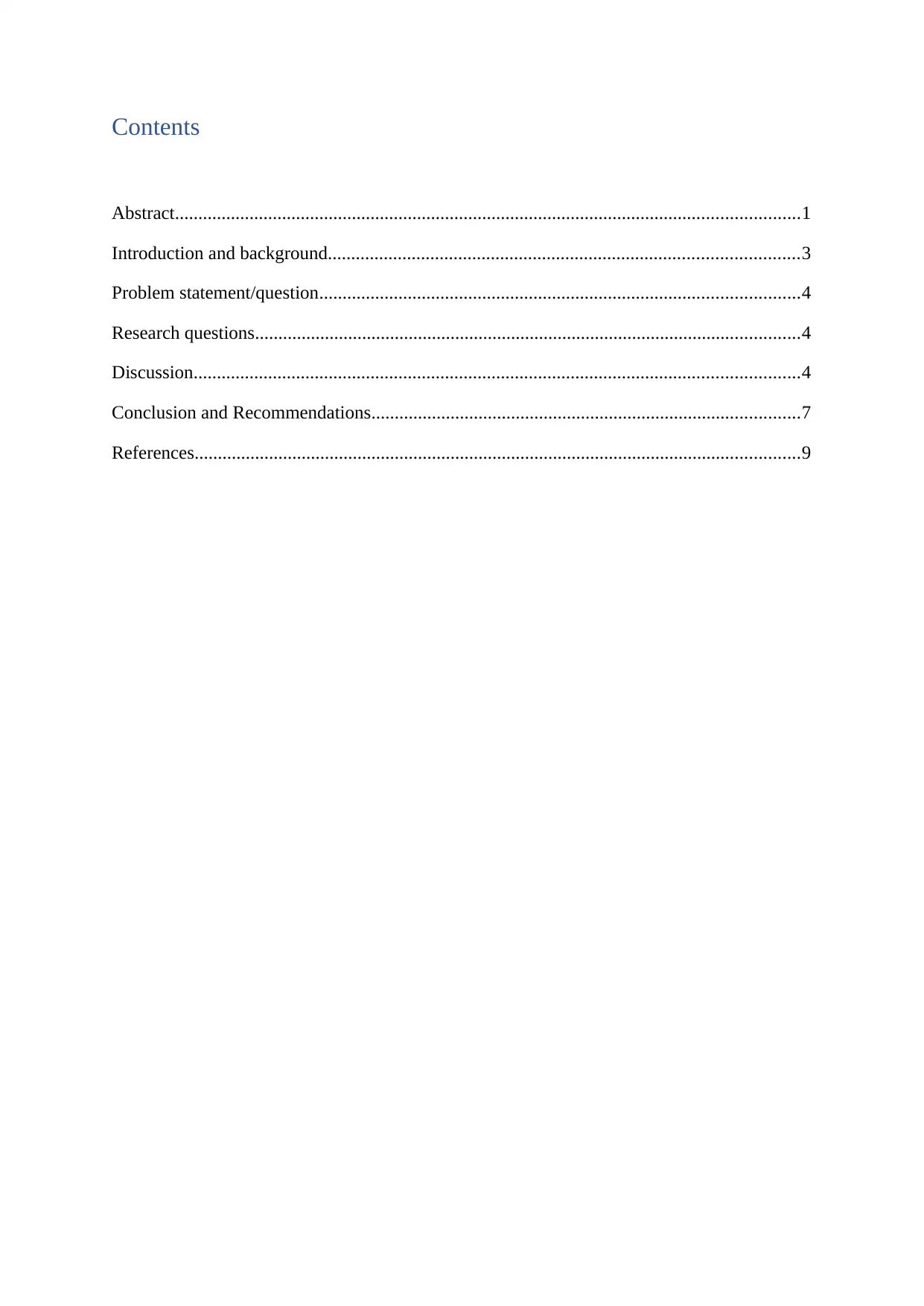
Contents
Abstract......................................................................................................................................1
Introduction and background.....................................................................................................3
Problem statement/question.......................................................................................................4
Research questions.....................................................................................................................4
Discussion..................................................................................................................................4
Conclusion and Recommendations............................................................................................7
References..................................................................................................................................9
Abstract......................................................................................................................................1
Introduction and background.....................................................................................................3
Problem statement/question.......................................................................................................4
Research questions.....................................................................................................................4
Discussion..................................................................................................................................4
Conclusion and Recommendations............................................................................................7
References..................................................................................................................................9
⊘ This is a preview!⊘
Do you want full access?
Subscribe today to unlock all pages.

Trusted by 1+ million students worldwide
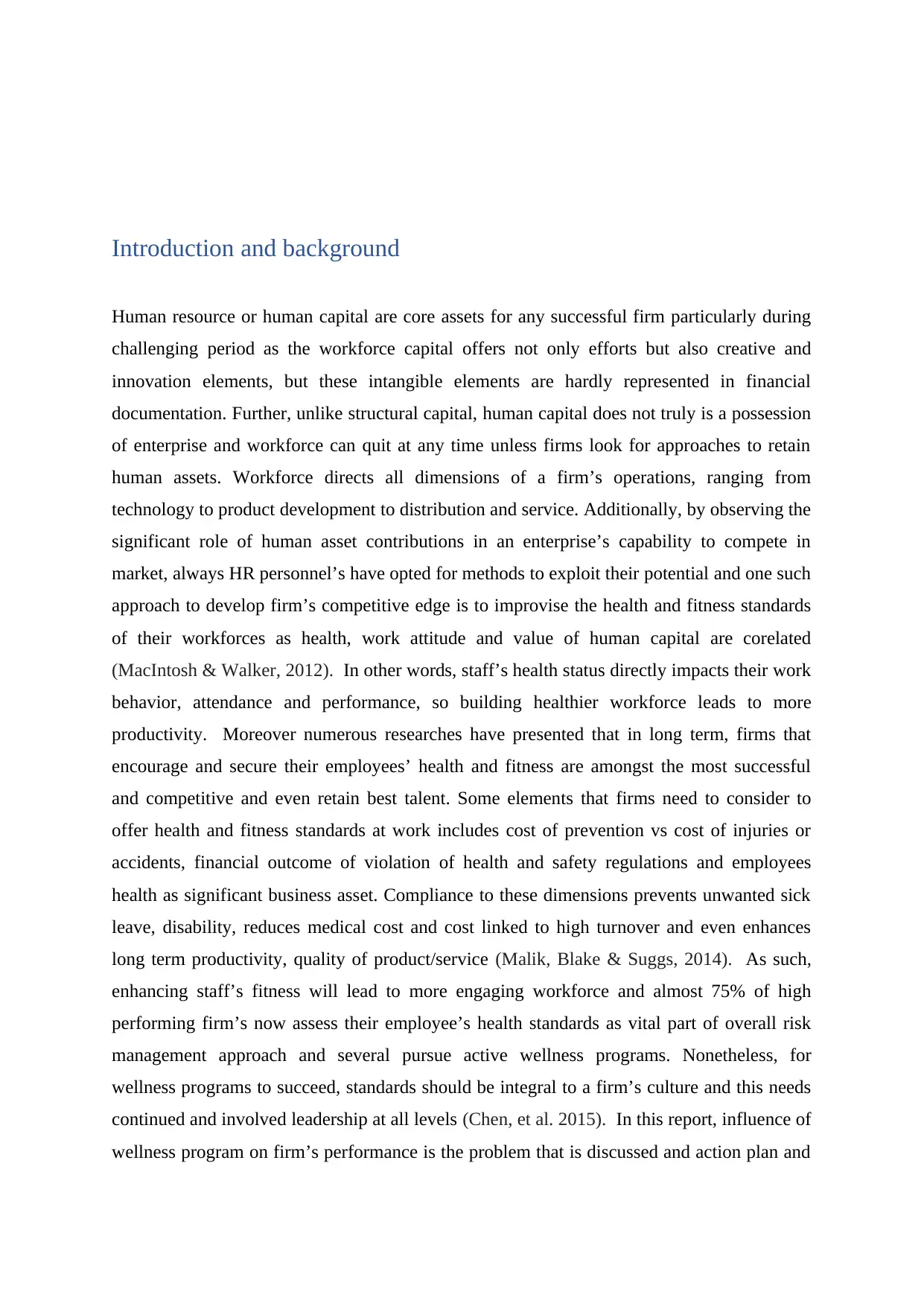
Introduction and background
Human resource or human capital are core assets for any successful firm particularly during
challenging period as the workforce capital offers not only efforts but also creative and
innovation elements, but these intangible elements are hardly represented in financial
documentation. Further, unlike structural capital, human capital does not truly is a possession
of enterprise and workforce can quit at any time unless firms look for approaches to retain
human assets. Workforce directs all dimensions of a firm’s operations, ranging from
technology to product development to distribution and service. Additionally, by observing the
significant role of human asset contributions in an enterprise’s capability to compete in
market, always HR personnel’s have opted for methods to exploit their potential and one such
approach to develop firm’s competitive edge is to improvise the health and fitness standards
of their workforces as health, work attitude and value of human capital are corelated
(MacIntosh & Walker, 2012). In other words, staff’s health status directly impacts their work
behavior, attendance and performance, so building healthier workforce leads to more
productivity. Moreover numerous researches have presented that in long term, firms that
encourage and secure their employees’ health and fitness are amongst the most successful
and competitive and even retain best talent. Some elements that firms need to consider to
offer health and fitness standards at work includes cost of prevention vs cost of injuries or
accidents, financial outcome of violation of health and safety regulations and employees
health as significant business asset. Compliance to these dimensions prevents unwanted sick
leave, disability, reduces medical cost and cost linked to high turnover and even enhances
long term productivity, quality of product/service (Malik, Blake & Suggs, 2014). As such,
enhancing staff’s fitness will lead to more engaging workforce and almost 75% of high
performing firm’s now assess their employee’s health standards as vital part of overall risk
management approach and several pursue active wellness programs. Nonetheless, for
wellness programs to succeed, standards should be integral to a firm’s culture and this needs
continued and involved leadership at all levels (Chen, et al. 2015). In this report, influence of
wellness program on firm’s performance is the problem that is discussed and action plan and
Human resource or human capital are core assets for any successful firm particularly during
challenging period as the workforce capital offers not only efforts but also creative and
innovation elements, but these intangible elements are hardly represented in financial
documentation. Further, unlike structural capital, human capital does not truly is a possession
of enterprise and workforce can quit at any time unless firms look for approaches to retain
human assets. Workforce directs all dimensions of a firm’s operations, ranging from
technology to product development to distribution and service. Additionally, by observing the
significant role of human asset contributions in an enterprise’s capability to compete in
market, always HR personnel’s have opted for methods to exploit their potential and one such
approach to develop firm’s competitive edge is to improvise the health and fitness standards
of their workforces as health, work attitude and value of human capital are corelated
(MacIntosh & Walker, 2012). In other words, staff’s health status directly impacts their work
behavior, attendance and performance, so building healthier workforce leads to more
productivity. Moreover numerous researches have presented that in long term, firms that
encourage and secure their employees’ health and fitness are amongst the most successful
and competitive and even retain best talent. Some elements that firms need to consider to
offer health and fitness standards at work includes cost of prevention vs cost of injuries or
accidents, financial outcome of violation of health and safety regulations and employees
health as significant business asset. Compliance to these dimensions prevents unwanted sick
leave, disability, reduces medical cost and cost linked to high turnover and even enhances
long term productivity, quality of product/service (Malik, Blake & Suggs, 2014). As such,
enhancing staff’s fitness will lead to more engaging workforce and almost 75% of high
performing firm’s now assess their employee’s health standards as vital part of overall risk
management approach and several pursue active wellness programs. Nonetheless, for
wellness programs to succeed, standards should be integral to a firm’s culture and this needs
continued and involved leadership at all levels (Chen, et al. 2015). In this report, influence of
wellness program on firm’s performance is the problem that is discussed and action plan and
Paraphrase This Document
Need a fresh take? Get an instant paraphrase of this document with our AI Paraphraser
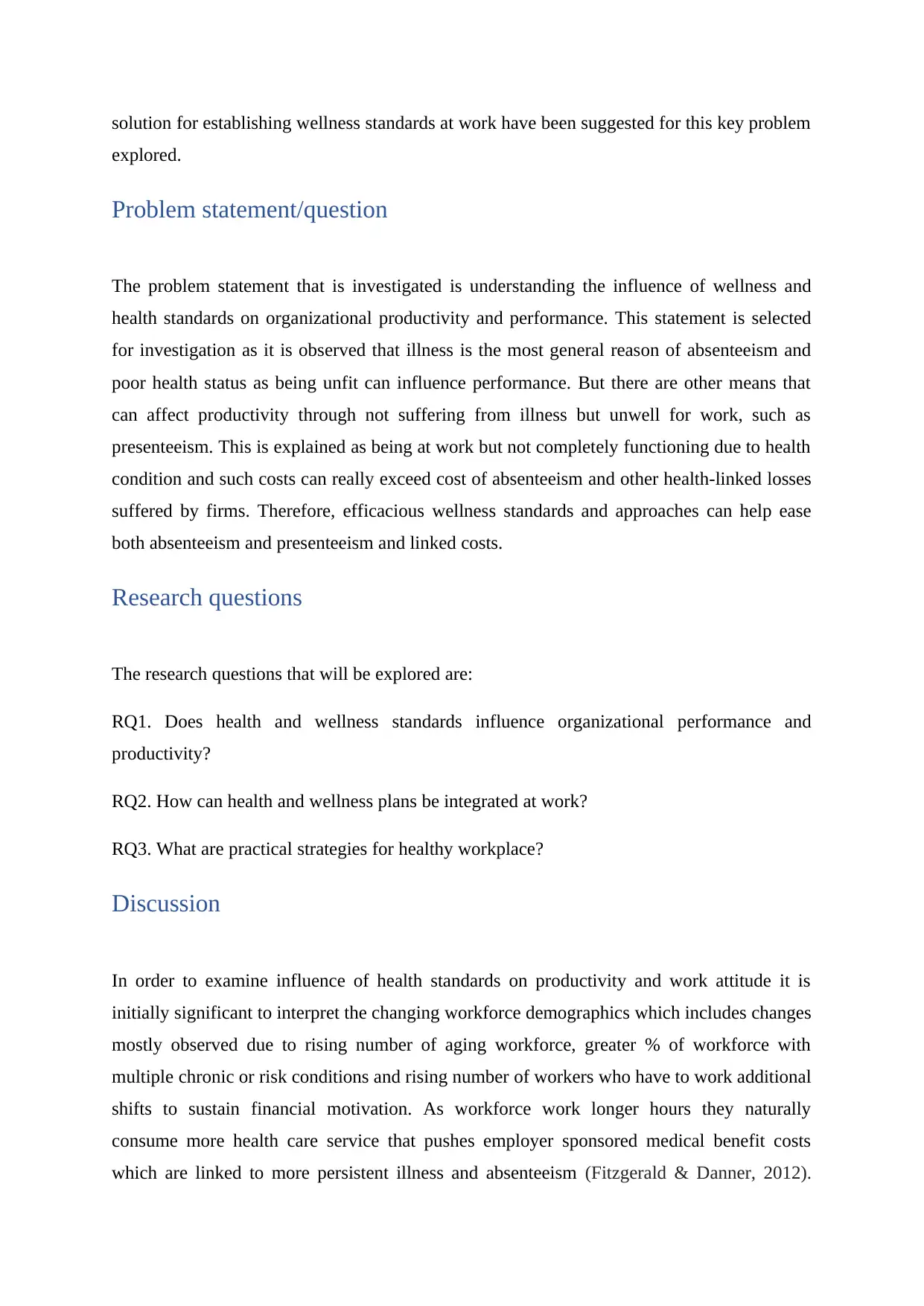
solution for establishing wellness standards at work have been suggested for this key problem
explored.
Problem statement/question
The problem statement that is investigated is understanding the influence of wellness and
health standards on organizational productivity and performance. This statement is selected
for investigation as it is observed that illness is the most general reason of absenteeism and
poor health status as being unfit can influence performance. But there are other means that
can affect productivity through not suffering from illness but unwell for work, such as
presenteeism. This is explained as being at work but not completely functioning due to health
condition and such costs can really exceed cost of absenteeism and other health-linked losses
suffered by firms. Therefore, efficacious wellness standards and approaches can help ease
both absenteeism and presenteeism and linked costs.
Research questions
The research questions that will be explored are:
RQ1. Does health and wellness standards influence organizational performance and
productivity?
RQ2. How can health and wellness plans be integrated at work?
RQ3. What are practical strategies for healthy workplace?
Discussion
In order to examine influence of health standards on productivity and work attitude it is
initially significant to interpret the changing workforce demographics which includes changes
mostly observed due to rising number of aging workforce, greater % of workforce with
multiple chronic or risk conditions and rising number of workers who have to work additional
shifts to sustain financial motivation. As workforce work longer hours they naturally
consume more health care service that pushes employer sponsored medical benefit costs
which are linked to more persistent illness and absenteeism (Fitzgerald & Danner, 2012).
explored.
Problem statement/question
The problem statement that is investigated is understanding the influence of wellness and
health standards on organizational productivity and performance. This statement is selected
for investigation as it is observed that illness is the most general reason of absenteeism and
poor health status as being unfit can influence performance. But there are other means that
can affect productivity through not suffering from illness but unwell for work, such as
presenteeism. This is explained as being at work but not completely functioning due to health
condition and such costs can really exceed cost of absenteeism and other health-linked losses
suffered by firms. Therefore, efficacious wellness standards and approaches can help ease
both absenteeism and presenteeism and linked costs.
Research questions
The research questions that will be explored are:
RQ1. Does health and wellness standards influence organizational performance and
productivity?
RQ2. How can health and wellness plans be integrated at work?
RQ3. What are practical strategies for healthy workplace?
Discussion
In order to examine influence of health standards on productivity and work attitude it is
initially significant to interpret the changing workforce demographics which includes changes
mostly observed due to rising number of aging workforce, greater % of workforce with
multiple chronic or risk conditions and rising number of workers who have to work additional
shifts to sustain financial motivation. As workforce work longer hours they naturally
consume more health care service that pushes employer sponsored medical benefit costs
which are linked to more persistent illness and absenteeism (Fitzgerald & Danner, 2012).

Also according to Adenuga (2015) International Labor Organization has estimated that
around 2.2 mn staffs die from occupational accidents and illness while 270 mn suffer from
injuries, 160 mn suffer illness in short or long period from work-linked reasons. Moreover
total of 5% of cost due to illness and injury is estimated in market economy due to work
which clearly presents significant loss due to adverse influence on economic growth and
productivity. Therefore, averting accidents and illness is definitely significant for business so
as to improve quality and productivity at work. Also strong health and wellness standard will
reduce absenteeism due to accident or diseases thus improving competitiveness of firms
(Chung, Gorm, Shklovski & Munson, 2017). These good practices can be attributed through
health and wellness standards that can encourage development of profits, quality and
performance at work. As health and productivity are corelated, so investing in wellness
standards should be seen as investment and not cost from outlook of productivity and value
creation as healthy human capital can lead to future development and also can motivate
skilled and efficacious workforce to contribute fully and actively to technical and
organizational innovation which is a prerequisite for a firm to work smoothly and
productively (Callen, Lindley & Niederhauser, 2013). Also illness and injuries at work can
have serious explicit and implicit outcomes on lives of employees and financial condition of
firms as cost to employers can be huge that can include pay for work not performed, medical
cost, reduction or temporary barrier to production, rising training cost, insurance or pension
costs, reduction in quality of work and adverse impact on worker morale. All these elements
hamper productivity and performance at work. Additional costs can even include cost of
replacing unwell employee, new staff training and time adjustment cost etc.
around 2.2 mn staffs die from occupational accidents and illness while 270 mn suffer from
injuries, 160 mn suffer illness in short or long period from work-linked reasons. Moreover
total of 5% of cost due to illness and injury is estimated in market economy due to work
which clearly presents significant loss due to adverse influence on economic growth and
productivity. Therefore, averting accidents and illness is definitely significant for business so
as to improve quality and productivity at work. Also strong health and wellness standard will
reduce absenteeism due to accident or diseases thus improving competitiveness of firms
(Chung, Gorm, Shklovski & Munson, 2017). These good practices can be attributed through
health and wellness standards that can encourage development of profits, quality and
performance at work. As health and productivity are corelated, so investing in wellness
standards should be seen as investment and not cost from outlook of productivity and value
creation as healthy human capital can lead to future development and also can motivate
skilled and efficacious workforce to contribute fully and actively to technical and
organizational innovation which is a prerequisite for a firm to work smoothly and
productively (Callen, Lindley & Niederhauser, 2013). Also illness and injuries at work can
have serious explicit and implicit outcomes on lives of employees and financial condition of
firms as cost to employers can be huge that can include pay for work not performed, medical
cost, reduction or temporary barrier to production, rising training cost, insurance or pension
costs, reduction in quality of work and adverse impact on worker morale. All these elements
hamper productivity and performance at work. Additional costs can even include cost of
replacing unwell employee, new staff training and time adjustment cost etc.
⊘ This is a preview!⊘
Do you want full access?
Subscribe today to unlock all pages.

Trusted by 1+ million students worldwide
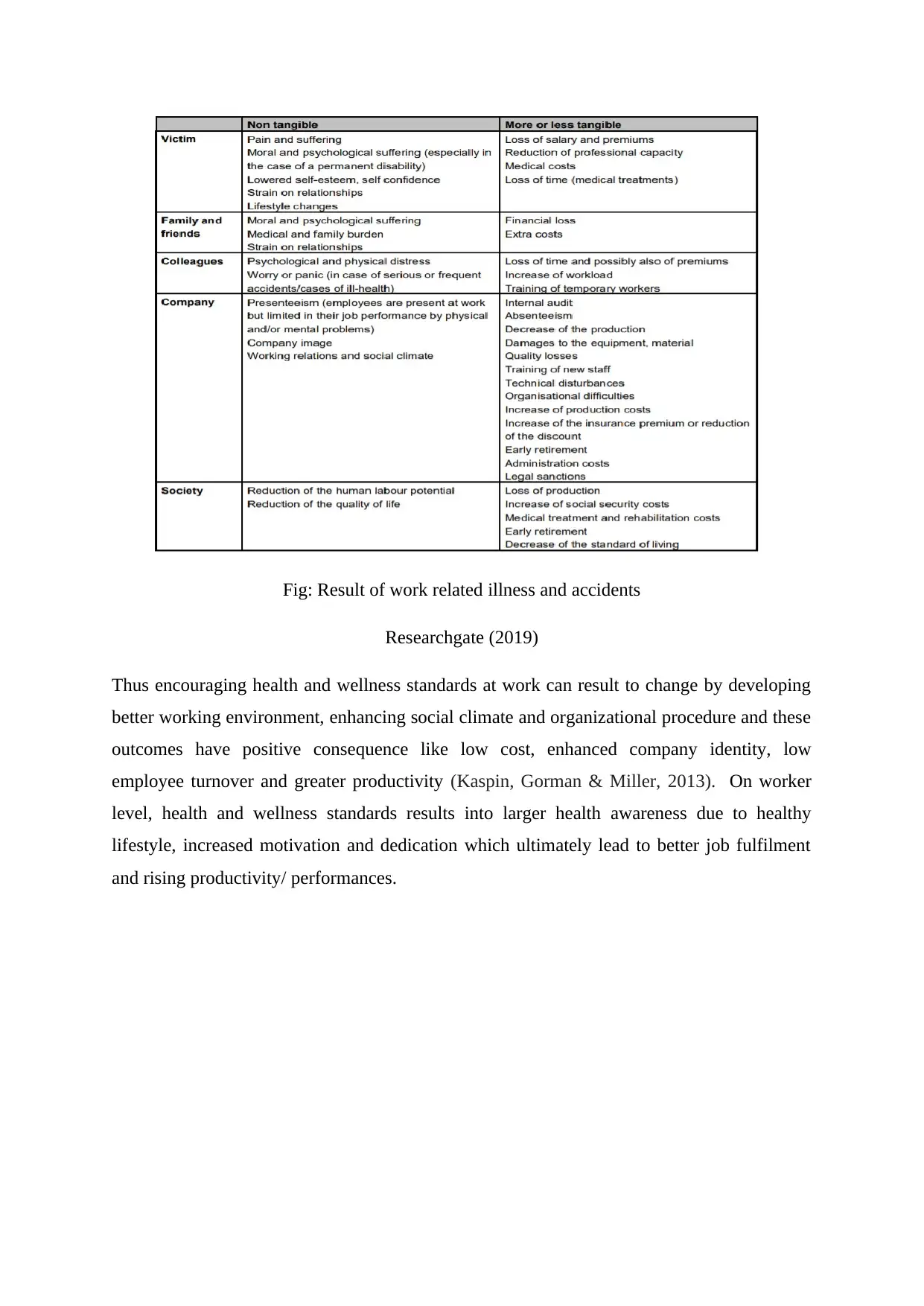
Fig: Result of work related illness and accidents
Researchgate (2019)
Thus encouraging health and wellness standards at work can result to change by developing
better working environment, enhancing social climate and organizational procedure and these
outcomes have positive consequence like low cost, enhanced company identity, low
employee turnover and greater productivity (Kaspin, Gorman & Miller, 2013). On worker
level, health and wellness standards results into larger health awareness due to healthy
lifestyle, increased motivation and dedication which ultimately lead to better job fulfilment
and rising productivity/ performances.
Researchgate (2019)
Thus encouraging health and wellness standards at work can result to change by developing
better working environment, enhancing social climate and organizational procedure and these
outcomes have positive consequence like low cost, enhanced company identity, low
employee turnover and greater productivity (Kaspin, Gorman & Miller, 2013). On worker
level, health and wellness standards results into larger health awareness due to healthy
lifestyle, increased motivation and dedication which ultimately lead to better job fulfilment
and rising productivity/ performances.
Paraphrase This Document
Need a fresh take? Get an instant paraphrase of this document with our AI Paraphraser
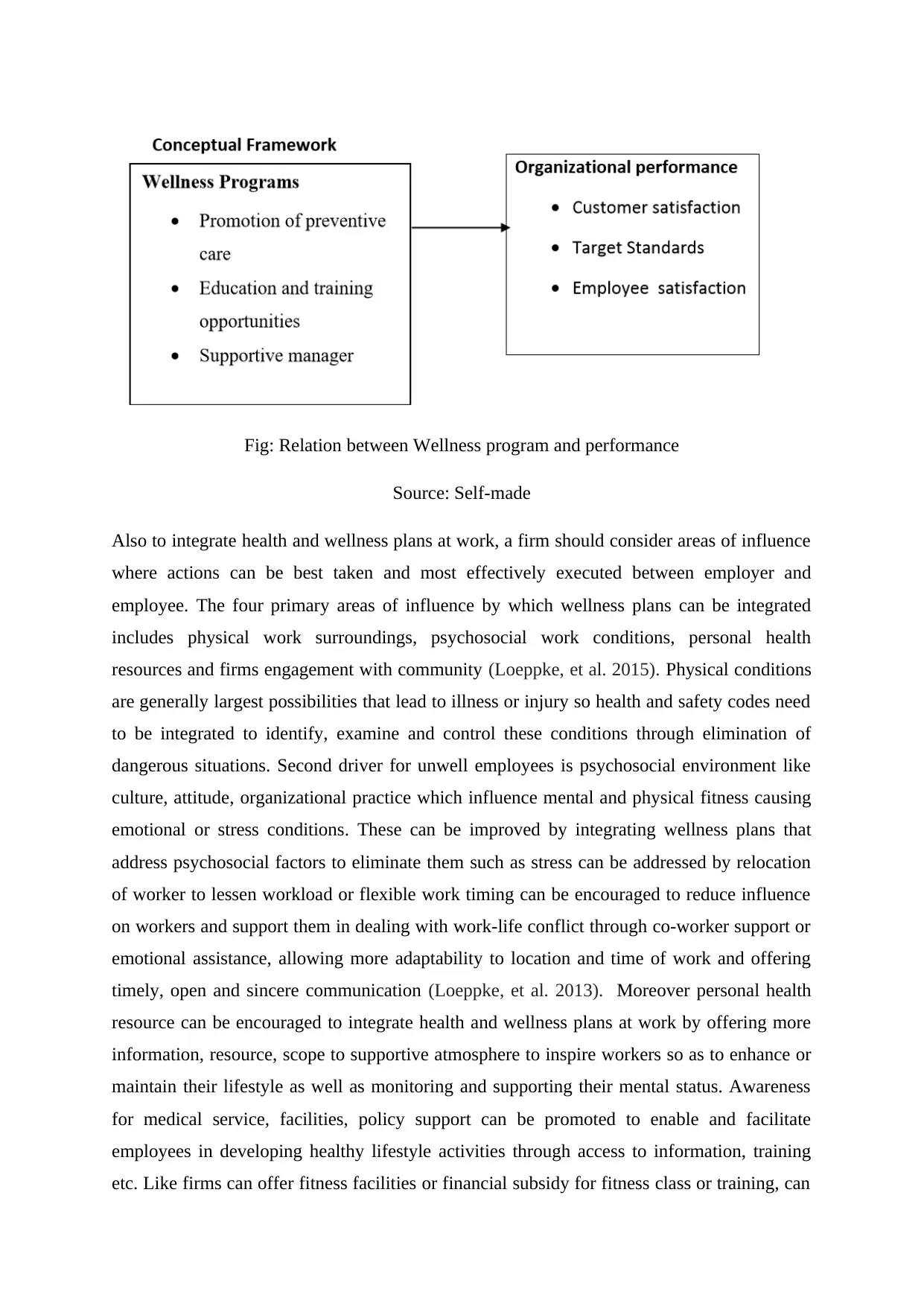
Fig: Relation between Wellness program and performance
Source: Self-made
Also to integrate health and wellness plans at work, a firm should consider areas of influence
where actions can be best taken and most effectively executed between employer and
employee. The four primary areas of influence by which wellness plans can be integrated
includes physical work surroundings, psychosocial work conditions, personal health
resources and firms engagement with community (Loeppke, et al. 2015). Physical conditions
are generally largest possibilities that lead to illness or injury so health and safety codes need
to be integrated to identify, examine and control these conditions through elimination of
dangerous situations. Second driver for unwell employees is psychosocial environment like
culture, attitude, organizational practice which influence mental and physical fitness causing
emotional or stress conditions. These can be improved by integrating wellness plans that
address psychosocial factors to eliminate them such as stress can be addressed by relocation
of worker to lessen workload or flexible work timing can be encouraged to reduce influence
on workers and support them in dealing with work-life conflict through co-worker support or
emotional assistance, allowing more adaptability to location and time of work and offering
timely, open and sincere communication (Loeppke, et al. 2013). Moreover personal health
resource can be encouraged to integrate health and wellness plans at work by offering more
information, resource, scope to supportive atmosphere to inspire workers so as to enhance or
maintain their lifestyle as well as monitoring and supporting their mental status. Awareness
for medical service, facilities, policy support can be promoted to enable and facilitate
employees in developing healthy lifestyle activities through access to information, training
etc. Like firms can offer fitness facilities or financial subsidy for fitness class or training, can
Source: Self-made
Also to integrate health and wellness plans at work, a firm should consider areas of influence
where actions can be best taken and most effectively executed between employer and
employee. The four primary areas of influence by which wellness plans can be integrated
includes physical work surroundings, psychosocial work conditions, personal health
resources and firms engagement with community (Loeppke, et al. 2015). Physical conditions
are generally largest possibilities that lead to illness or injury so health and safety codes need
to be integrated to identify, examine and control these conditions through elimination of
dangerous situations. Second driver for unwell employees is psychosocial environment like
culture, attitude, organizational practice which influence mental and physical fitness causing
emotional or stress conditions. These can be improved by integrating wellness plans that
address psychosocial factors to eliminate them such as stress can be addressed by relocation
of worker to lessen workload or flexible work timing can be encouraged to reduce influence
on workers and support them in dealing with work-life conflict through co-worker support or
emotional assistance, allowing more adaptability to location and time of work and offering
timely, open and sincere communication (Loeppke, et al. 2013). Moreover personal health
resource can be encouraged to integrate health and wellness plans at work by offering more
information, resource, scope to supportive atmosphere to inspire workers so as to enhance or
maintain their lifestyle as well as monitoring and supporting their mental status. Awareness
for medical service, facilities, policy support can be promoted to enable and facilitate
employees in developing healthy lifestyle activities through access to information, training
etc. Like firms can offer fitness facilities or financial subsidy for fitness class or training, can

promote walking/cycling to adapt workers to stress and process, can offer subsidized healthy
food alternative in canteens and vending machines at workplace, can permit flexibility in
timing and length of work breaks for exercise (Tetrick & Winslow, 2015).
Therefore wellness programs and provisions to encourage healthy workplace can be built
practically by including facilitation and support for preventive health care, education and
training possibilities on wellness as well as by offering support from supervisors on wellness
concerns (Shaw, Reme & Boot, 2012). As all these approaches have linear association with
organizational goals, worker fulfilment and customer fulfilment so it implies that health and
fitness standards play a vital role in influencing organizational performance and productivity
as it is broadly observed that promoting wellness not only benefits workers by making them
healthy, productive and satisfied but it even benefits firms through retaining talented
workforce which naturally gets translated to improved organizational performances.
Conclusion and Recommendations
In order to facilitate health and wellness program, it is needed that healthier attitude of
workers is promoted and it is recommended that these can be developed through cultivation
of multi-level leadership where employees can be requested to share their opinion to
encourage their involvement at all levels in order to successfully push wellness initiated
cultural transformation at work (De La Torre & Goetzel, 2016). Another recommendation is
to enhance worker’s physical activity where signs can be placed through stairs at workplace
to remind workers to walk up stair rather than taking elevator or fitness program can be
provided to promote healthy lifestyle. Also workers can be promoted to take stretch breaks or
can be given discounted fitness club membership. Moreover departmental competition or
rewards can be offered to workers who meet monthly exercise targets which can promote
healthy behavior at work (Kent, et al. 2016). Thirdly good nutrition intake can be encouraged
in workers where vending machines or cafeterias at workplaces can offer healthier
alternatives. Other initiatives than can be included are organizing healthy potluck or recipe
exchange at work, providing vegetable/fruit snacks rather than junk items during official
meets and offering discount on cost of heart-healthy entrée’s at cafeteria’s. It is also
recommended that workers need to be educated on healthy lifestyle to promote wellness
standard and intentions where health tips can be shared to all workers over emails, bulletin
boards can maintain health information in high density areas at work (Jinnett, et al. 2017).
food alternative in canteens and vending machines at workplace, can permit flexibility in
timing and length of work breaks for exercise (Tetrick & Winslow, 2015).
Therefore wellness programs and provisions to encourage healthy workplace can be built
practically by including facilitation and support for preventive health care, education and
training possibilities on wellness as well as by offering support from supervisors on wellness
concerns (Shaw, Reme & Boot, 2012). As all these approaches have linear association with
organizational goals, worker fulfilment and customer fulfilment so it implies that health and
fitness standards play a vital role in influencing organizational performance and productivity
as it is broadly observed that promoting wellness not only benefits workers by making them
healthy, productive and satisfied but it even benefits firms through retaining talented
workforce which naturally gets translated to improved organizational performances.
Conclusion and Recommendations
In order to facilitate health and wellness program, it is needed that healthier attitude of
workers is promoted and it is recommended that these can be developed through cultivation
of multi-level leadership where employees can be requested to share their opinion to
encourage their involvement at all levels in order to successfully push wellness initiated
cultural transformation at work (De La Torre & Goetzel, 2016). Another recommendation is
to enhance worker’s physical activity where signs can be placed through stairs at workplace
to remind workers to walk up stair rather than taking elevator or fitness program can be
provided to promote healthy lifestyle. Also workers can be promoted to take stretch breaks or
can be given discounted fitness club membership. Moreover departmental competition or
rewards can be offered to workers who meet monthly exercise targets which can promote
healthy behavior at work (Kent, et al. 2016). Thirdly good nutrition intake can be encouraged
in workers where vending machines or cafeterias at workplaces can offer healthier
alternatives. Other initiatives than can be included are organizing healthy potluck or recipe
exchange at work, providing vegetable/fruit snacks rather than junk items during official
meets and offering discount on cost of heart-healthy entrée’s at cafeteria’s. It is also
recommended that workers need to be educated on healthy lifestyle to promote wellness
standard and intentions where health tips can be shared to all workers over emails, bulletin
boards can maintain health information in high density areas at work (Jinnett, et al. 2017).
⊘ This is a preview!⊘
Do you want full access?
Subscribe today to unlock all pages.

Trusted by 1+ million students worldwide
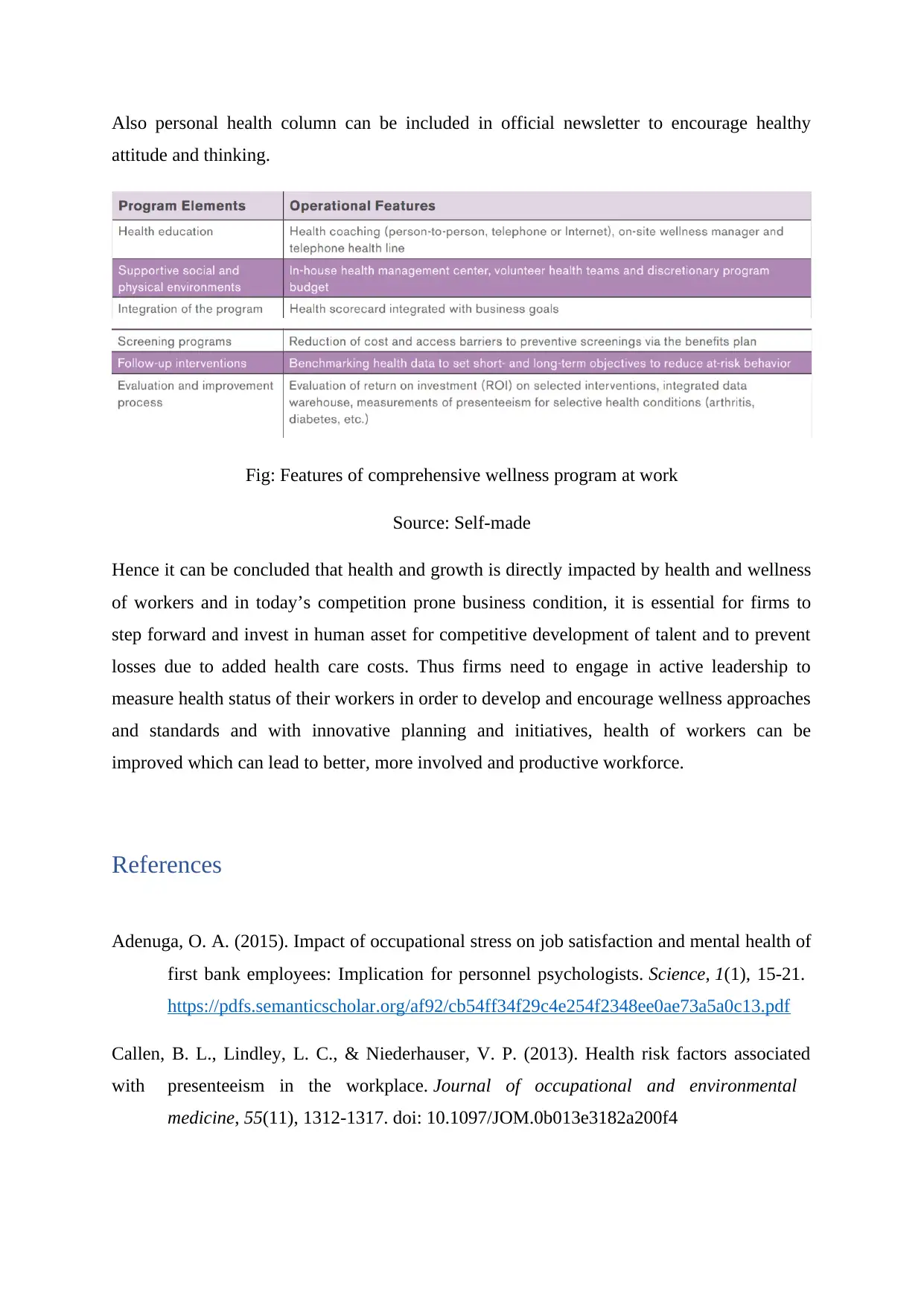
Also personal health column can be included in official newsletter to encourage healthy
attitude and thinking.
Fig: Features of comprehensive wellness program at work
Source: Self-made
Hence it can be concluded that health and growth is directly impacted by health and wellness
of workers and in today’s competition prone business condition, it is essential for firms to
step forward and invest in human asset for competitive development of talent and to prevent
losses due to added health care costs. Thus firms need to engage in active leadership to
measure health status of their workers in order to develop and encourage wellness approaches
and standards and with innovative planning and initiatives, health of workers can be
improved which can lead to better, more involved and productive workforce.
References
Adenuga, O. A. (2015). Impact of occupational stress on job satisfaction and mental health of
first bank employees: Implication for personnel psychologists. Science, 1(1), 15-21.
https://pdfs.semanticscholar.org/af92/cb54ff34f29c4e254f2348ee0ae73a5a0c13.pdf
Callen, B. L., Lindley, L. C., & Niederhauser, V. P. (2013). Health risk factors associated
with presenteeism in the workplace. Journal of occupational and environmental
medicine, 55(11), 1312-1317. doi: 10.1097/JOM.0b013e3182a200f4
attitude and thinking.
Fig: Features of comprehensive wellness program at work
Source: Self-made
Hence it can be concluded that health and growth is directly impacted by health and wellness
of workers and in today’s competition prone business condition, it is essential for firms to
step forward and invest in human asset for competitive development of talent and to prevent
losses due to added health care costs. Thus firms need to engage in active leadership to
measure health status of their workers in order to develop and encourage wellness approaches
and standards and with innovative planning and initiatives, health of workers can be
improved which can lead to better, more involved and productive workforce.
References
Adenuga, O. A. (2015). Impact of occupational stress on job satisfaction and mental health of
first bank employees: Implication for personnel psychologists. Science, 1(1), 15-21.
https://pdfs.semanticscholar.org/af92/cb54ff34f29c4e254f2348ee0ae73a5a0c13.pdf
Callen, B. L., Lindley, L. C., & Niederhauser, V. P. (2013). Health risk factors associated
with presenteeism in the workplace. Journal of occupational and environmental
medicine, 55(11), 1312-1317. doi: 10.1097/JOM.0b013e3182a200f4
Paraphrase This Document
Need a fresh take? Get an instant paraphrase of this document with our AI Paraphraser
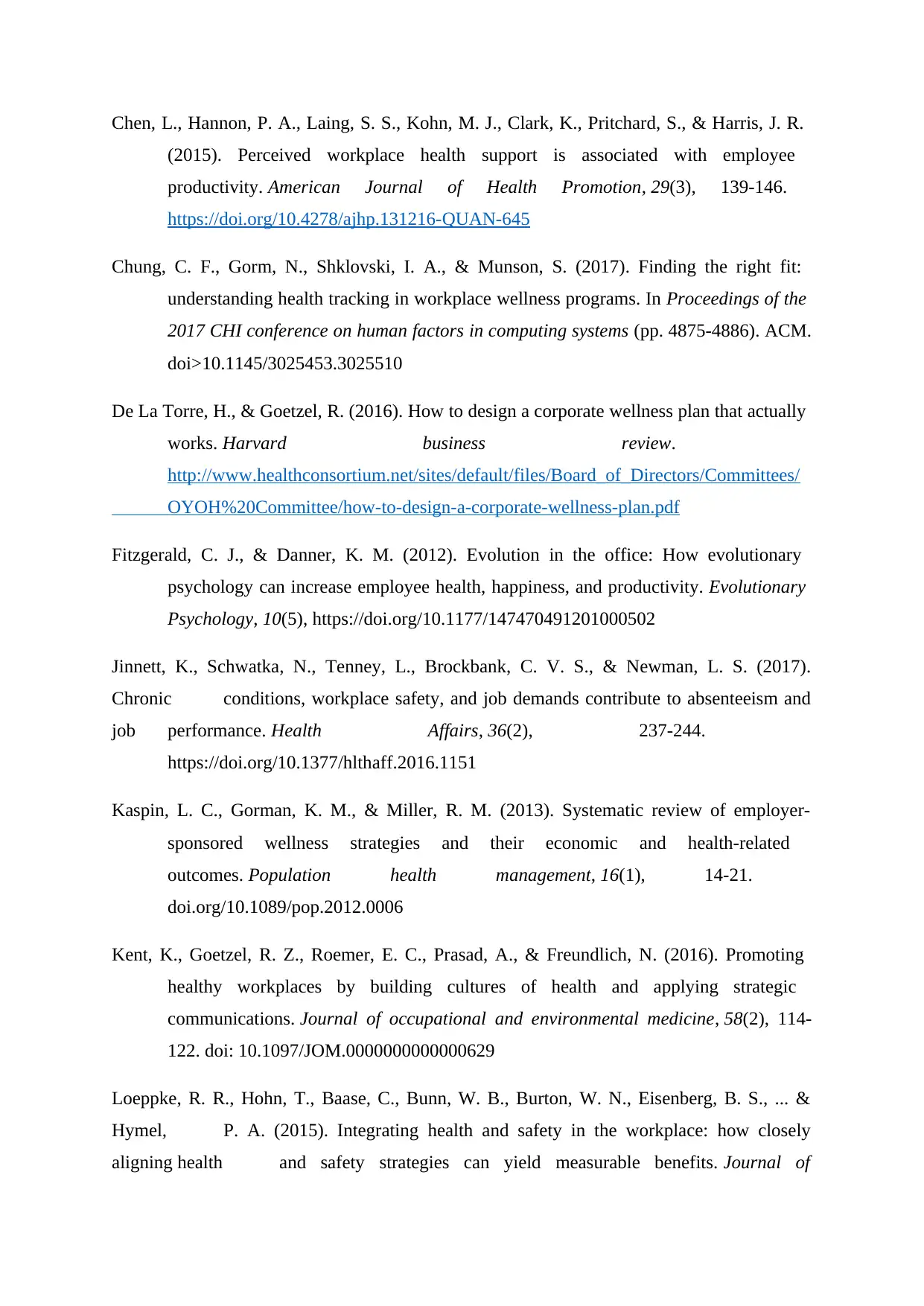
Chen, L., Hannon, P. A., Laing, S. S., Kohn, M. J., Clark, K., Pritchard, S., & Harris, J. R.
(2015). Perceived workplace health support is associated with employee
productivity. American Journal of Health Promotion, 29(3), 139-146.
https://doi.org/10.4278/ajhp.131216-QUAN-645
Chung, C. F., Gorm, N., Shklovski, I. A., & Munson, S. (2017). Finding the right fit:
understanding health tracking in workplace wellness programs. In Proceedings of the
2017 CHI conference on human factors in computing systems (pp. 4875-4886). ACM.
doi>10.1145/3025453.3025510
De La Torre, H., & Goetzel, R. (2016). How to design a corporate wellness plan that actually
works. Harvard business review.
http://www.healthconsortium.net/sites/default/files/Board_of_Directors/Committees/
OYOH%20Committee/how-to-design-a-corporate-wellness-plan.pdf
Fitzgerald, C. J., & Danner, K. M. (2012). Evolution in the office: How evolutionary
psychology can increase employee health, happiness, and productivity. Evolutionary
Psychology, 10(5), https://doi.org/10.1177/147470491201000502
Jinnett, K., Schwatka, N., Tenney, L., Brockbank, C. V. S., & Newman, L. S. (2017).
Chronic conditions, workplace safety, and job demands contribute to absenteeism and
job performance. Health Affairs, 36(2), 237-244.
https://doi.org/10.1377/hlthaff.2016.1151
Kaspin, L. C., Gorman, K. M., & Miller, R. M. (2013). Systematic review of employer-
sponsored wellness strategies and their economic and health-related
outcomes. Population health management, 16(1), 14-21.
doi.org/10.1089/pop.2012.0006
Kent, K., Goetzel, R. Z., Roemer, E. C., Prasad, A., & Freundlich, N. (2016). Promoting
healthy workplaces by building cultures of health and applying strategic
communications. Journal of occupational and environmental medicine, 58(2), 114-
122. doi: 10.1097/JOM.0000000000000629
Loeppke, R. R., Hohn, T., Baase, C., Bunn, W. B., Burton, W. N., Eisenberg, B. S., ... &
Hymel, P. A. (2015). Integrating health and safety in the workplace: how closely
aligning health and safety strategies can yield measurable benefits. Journal of
(2015). Perceived workplace health support is associated with employee
productivity. American Journal of Health Promotion, 29(3), 139-146.
https://doi.org/10.4278/ajhp.131216-QUAN-645
Chung, C. F., Gorm, N., Shklovski, I. A., & Munson, S. (2017). Finding the right fit:
understanding health tracking in workplace wellness programs. In Proceedings of the
2017 CHI conference on human factors in computing systems (pp. 4875-4886). ACM.
doi>10.1145/3025453.3025510
De La Torre, H., & Goetzel, R. (2016). How to design a corporate wellness plan that actually
works. Harvard business review.
http://www.healthconsortium.net/sites/default/files/Board_of_Directors/Committees/
OYOH%20Committee/how-to-design-a-corporate-wellness-plan.pdf
Fitzgerald, C. J., & Danner, K. M. (2012). Evolution in the office: How evolutionary
psychology can increase employee health, happiness, and productivity. Evolutionary
Psychology, 10(5), https://doi.org/10.1177/147470491201000502
Jinnett, K., Schwatka, N., Tenney, L., Brockbank, C. V. S., & Newman, L. S. (2017).
Chronic conditions, workplace safety, and job demands contribute to absenteeism and
job performance. Health Affairs, 36(2), 237-244.
https://doi.org/10.1377/hlthaff.2016.1151
Kaspin, L. C., Gorman, K. M., & Miller, R. M. (2013). Systematic review of employer-
sponsored wellness strategies and their economic and health-related
outcomes. Population health management, 16(1), 14-21.
doi.org/10.1089/pop.2012.0006
Kent, K., Goetzel, R. Z., Roemer, E. C., Prasad, A., & Freundlich, N. (2016). Promoting
healthy workplaces by building cultures of health and applying strategic
communications. Journal of occupational and environmental medicine, 58(2), 114-
122. doi: 10.1097/JOM.0000000000000629
Loeppke, R. R., Hohn, T., Baase, C., Bunn, W. B., Burton, W. N., Eisenberg, B. S., ... &
Hymel, P. A. (2015). Integrating health and safety in the workplace: how closely
aligning health and safety strategies can yield measurable benefits. Journal of
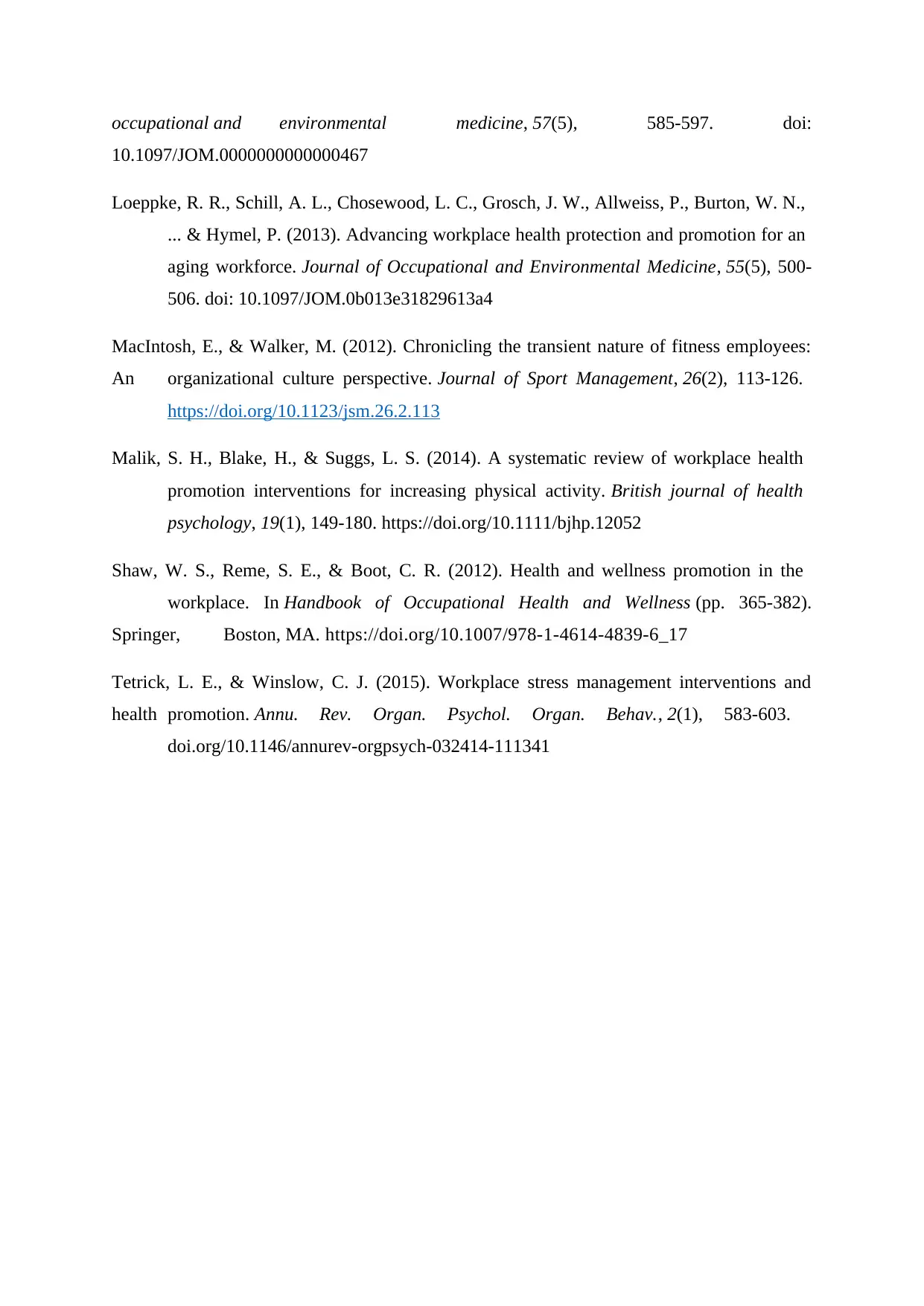
occupational and environmental medicine, 57(5), 585-597. doi:
10.1097/JOM.0000000000000467
Loeppke, R. R., Schill, A. L., Chosewood, L. C., Grosch, J. W., Allweiss, P., Burton, W. N.,
... & Hymel, P. (2013). Advancing workplace health protection and promotion for an
aging workforce. Journal of Occupational and Environmental Medicine, 55(5), 500-
506. doi: 10.1097/JOM.0b013e31829613a4
MacIntosh, E., & Walker, M. (2012). Chronicling the transient nature of fitness employees:
An organizational culture perspective. Journal of Sport Management, 26(2), 113-126.
https://doi.org/10.1123/jsm.26.2.113
Malik, S. H., Blake, H., & Suggs, L. S. (2014). A systematic review of workplace health
promotion interventions for increasing physical activity. British journal of health
psychology, 19(1), 149-180. https://doi.org/10.1111/bjhp.12052
Shaw, W. S., Reme, S. E., & Boot, C. R. (2012). Health and wellness promotion in the
workplace. In Handbook of Occupational Health and Wellness (pp. 365-382).
Springer, Boston, MA. https://doi.org/10.1007/978-1-4614-4839-6_17
Tetrick, L. E., & Winslow, C. J. (2015). Workplace stress management interventions and
health promotion. Annu. Rev. Organ. Psychol. Organ. Behav., 2(1), 583-603.
doi.org/10.1146/annurev-orgpsych-032414-111341
10.1097/JOM.0000000000000467
Loeppke, R. R., Schill, A. L., Chosewood, L. C., Grosch, J. W., Allweiss, P., Burton, W. N.,
... & Hymel, P. (2013). Advancing workplace health protection and promotion for an
aging workforce. Journal of Occupational and Environmental Medicine, 55(5), 500-
506. doi: 10.1097/JOM.0b013e31829613a4
MacIntosh, E., & Walker, M. (2012). Chronicling the transient nature of fitness employees:
An organizational culture perspective. Journal of Sport Management, 26(2), 113-126.
https://doi.org/10.1123/jsm.26.2.113
Malik, S. H., Blake, H., & Suggs, L. S. (2014). A systematic review of workplace health
promotion interventions for increasing physical activity. British journal of health
psychology, 19(1), 149-180. https://doi.org/10.1111/bjhp.12052
Shaw, W. S., Reme, S. E., & Boot, C. R. (2012). Health and wellness promotion in the
workplace. In Handbook of Occupational Health and Wellness (pp. 365-382).
Springer, Boston, MA. https://doi.org/10.1007/978-1-4614-4839-6_17
Tetrick, L. E., & Winslow, C. J. (2015). Workplace stress management interventions and
health promotion. Annu. Rev. Organ. Psychol. Organ. Behav., 2(1), 583-603.
doi.org/10.1146/annurev-orgpsych-032414-111341
⊘ This is a preview!⊘
Do you want full access?
Subscribe today to unlock all pages.

Trusted by 1+ million students worldwide
1 out of 12
Related Documents
Your All-in-One AI-Powered Toolkit for Academic Success.
+13062052269
info@desklib.com
Available 24*7 on WhatsApp / Email
![[object Object]](/_next/static/media/star-bottom.7253800d.svg)
Unlock your academic potential
Copyright © 2020–2025 A2Z Services. All Rights Reserved. Developed and managed by ZUCOL.





